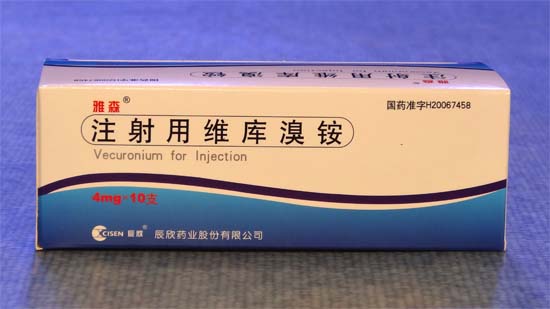Description: Vecuronium Bromide for Injection is a nondepolarizing neuromuscular blocking agent of intermediate duration, chemically designated as piperidinium, 1-[(2β, 3α, 5α, 16β, 17β)-3, 17-bis (acetyloxy)-2-(1-piperidinyl) androstan-16-yl]-1-methyl- bromide. Vecuronium Bromide for Injection is supplied as a sterile nonpyrogenic freeze-dried buffered cake of very fine microscopic crystalline particles for intravenous injection only.
Pharmacological effects: Vecuronium bromide for Injection is a nondepolarizing neuromuscular blocking agent possessing all of the characteristic pharmacological actions of this class of drugs (curariform). It acts by competing for cholinergic receptors at the motor end-plate. The antagonism to acetylcholine is inhibited and neuromuscular block is reversed by acetylcholinesterase inhibitors such as neostigmine, edrophonium, and pyridostigmine. Vecuronium bromide for Injection is about one-third more potent than pancuronium; the duration of neuromuscular blockade produced by vecuronium bromide for Injection is shorter than that of pancuronium at initially equipotent doses. The time to onset of paralysis decreases and the duration of maximum effect increases with increasing vecuronium bromide for Injection doses. The use of a peripheral nerve stimulator is recommended in assessing the degree of muscular relaxation with all neuromuscular blocking drugs. The ED90 (dose required to produce 90% suppression of the muscle twitch response with balanced anesthesia) has averaged 0.057 mg/kg (0.049–0.062 mg/kg in various studies). An initial vecuronium bromide for Injection dose of 0.08 to 0.10 mg/kg generally produces first depression of twitch in approximately 1 minute, good or excellent intubation conditions within 2.5 to 3 minutes, and maximum neuromuscular blockade within 3 to 5 minutes of injection in most patients. Under balanced anesthesia, the time to recovery to 25% of control (clinical duration) is approximately 25 to 40 minutes after injection and recovery is usually 95% complete approximately 45 to 65 minutes after injection of intubating dose. The neuromuscular blocking action of vecuronium bromide for Injection is slightly enhanced in the presence of potent inhalation anesthetics. If vecuronium bromide for Injection is first administered more than 5 minutes after the start of the inhalation of enflurane, isoflurane, or halothane, or when steady-state has been achieved, the intubating dose of vecuronium bromide for Injection may be decreased by approximately 15%. Prior administration of succinylcholine may enhance the neuromuscular blocking effect of vecuronium bromide for Injection and its duration of action. With succinylcholine as the intubating agent, initial doses of 0.04 to 0.06 mg/kg of vecuronium bromide for Injection will produce complete neuromuscular block with clinical duration of action of 25 to 30 minutes. If succinylcholine is used prior to vecuronium bromide for Injection, Repeated administration of maintenance doses of vecuronium bromide for Injection has little or no cumulative effect on the duration of neuromuscular blockade. Therefore, repeat doses can be administered at relatively regular intervals with predictable results. After an initial dose of 0.08 to 0.10 mg/kg under balanced anesthesia, the first maintenance dose (suggested maintenance dose is 0.010 to 0.015 mg/kg) is generally required within 25 to 40 minutes; subsequent maintenance doses, if required, may be administered at approximately 12 to 15 minute intervals. Halothane anesthesia increases the clinical duration of the maintenance dose only slightly. Under enflurane a maintenance dose of 0.010 mg/kg is approximately equal to 0.015 mg/kg dose under balanced anesthesia.The recovery index (time from 25 to 75% recovery) is approximately 15 to 25 minutes under balanced or halothane anesthesia. When recovery from vecuronium bromide for Injection neuromuscular blocking effect begins, it proceeds more rapidly than recovery from pancuronium. Once spontaneous recovery has started, the neuromuscular block produced by vecuronium bromide for Injection is readily reversed with various anticholinesterase agents, e.g., pyridostigmine, neostigmine, or edrophonium, in conjunction with an anticholinergic agent such as atropine or glycopyrrolate.
Pharmacokinetics: At clinical doses of 0.04 to 0.10 mg/kg, 60 to 80% of vecuronium bromide for Injection is usually bound to plasma protein. The distribution half-life following a single intravenous dose (range 0.025–0.280 mg/kg) is approximately 4 minutes. Elimination half-life over this sample dosage range is approximately 65 to 75 minutes in healthy surgical patients and in renal failure patients undergoing transplant surgery. In late pregnancy, elimination half-life may be shortened to approximately 35 to 40 minutes. The volume of distribution at steady-state is approximately 300 to 400 mL/kg; systemic rate of clearance is approximately 3 to 4.5 mL/kg/min. In man, urine recovery of vecuronium bromide for Injection varies from 3 to 35% within 24 hours. Unlike other nondepolarizing skeletal muscle relaxants, vecuronium bromide for Injection has no clinically significant effects on hemodynamic parameters. Vecuronium bromide for Injection will not counteract those hemodynamic changes or known side effects produced by or associated with anesthetic agents, other drugs, or various other factors known to alter hemodynamics.
Indications: Vecuronium Bromide for Injection is indicated as an adjunct to general anesthesia, to facilitate endotracheal intubation and to provide skeletal muscle relaxation during surgery or mechanical ventilation.
Precautions: Tell the doctor your medical history, including: any allergies, heart disease, lung problems (e.g., asthma, COPD), nerve-muscle conditions (e.g., myasthenia gravis, Eaton-Lambert syndrome), kidney or liver disorders, electrolyte imbalances (e.g., hypokalemia, hypermagnesemia, hypercalcemia), adrenal gland problems (e.g., Addison's disease), cancer. A preservative (benzyl alcohol) which may be found in this product or in the liquid used to mix this product (diluent) can infrequently cause serious problems (sometimes death), if given in large amounts (more than 100 mg/kg daily) to an infant during the first months of life (neonatal period). The risk is also greater with low birth weight infants. Symptoms include sudden gasping, low blood pressure, or a very slow heartbeat. Report these symptoms to the doctor immediately should they occur. If possible, a preservative-free product should be used when treating neonates. Children 7 weeks to 1 year of age are more sensitive to the effects of this medication. Use cautiously. This medication should be used only when clearly needed during pregnancy. Discuss the risks and benefits with your doctor. It is not known whether this drug passes into breast milk. Consult your doctor before breast-feeding.
Adverse reaction: Redness at the injection site, prolonged muscle weakness, unusually fast or slow heart rate, dizziness, fever.

